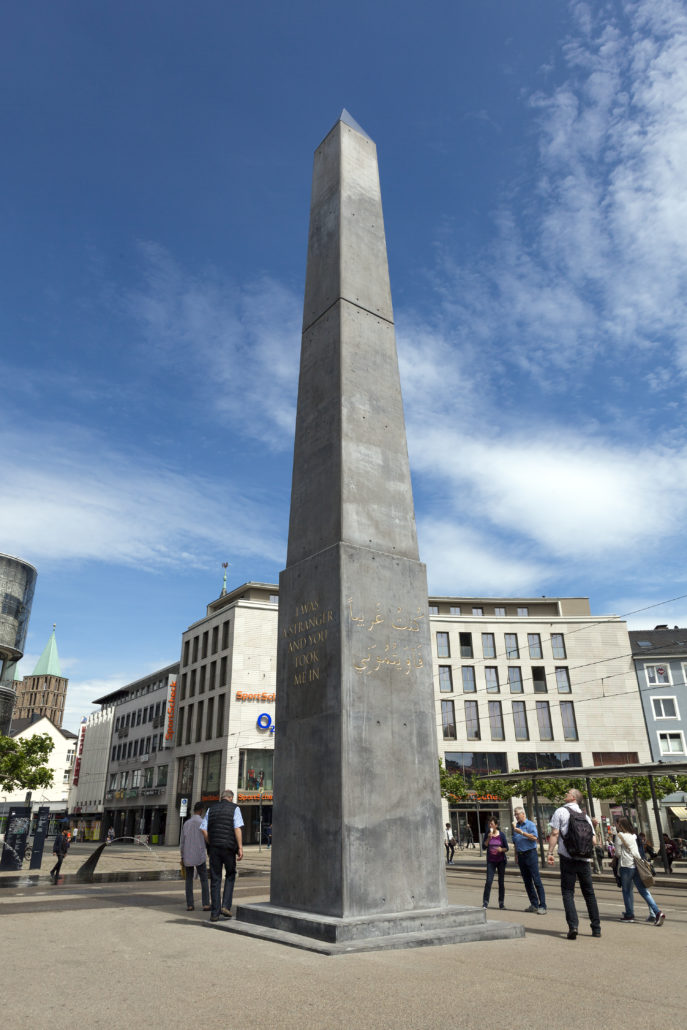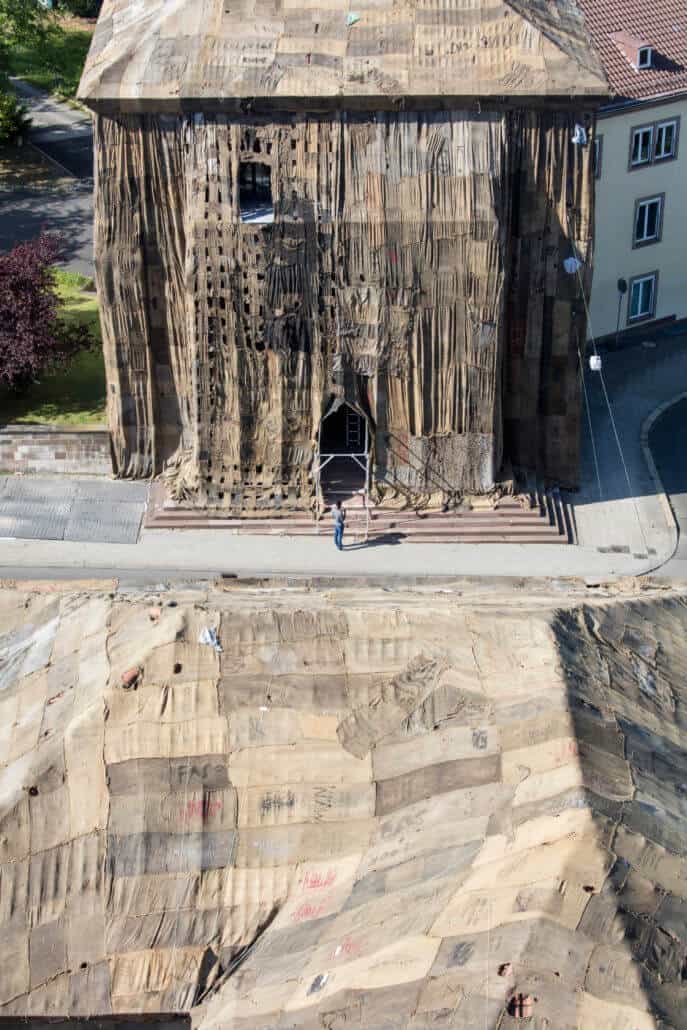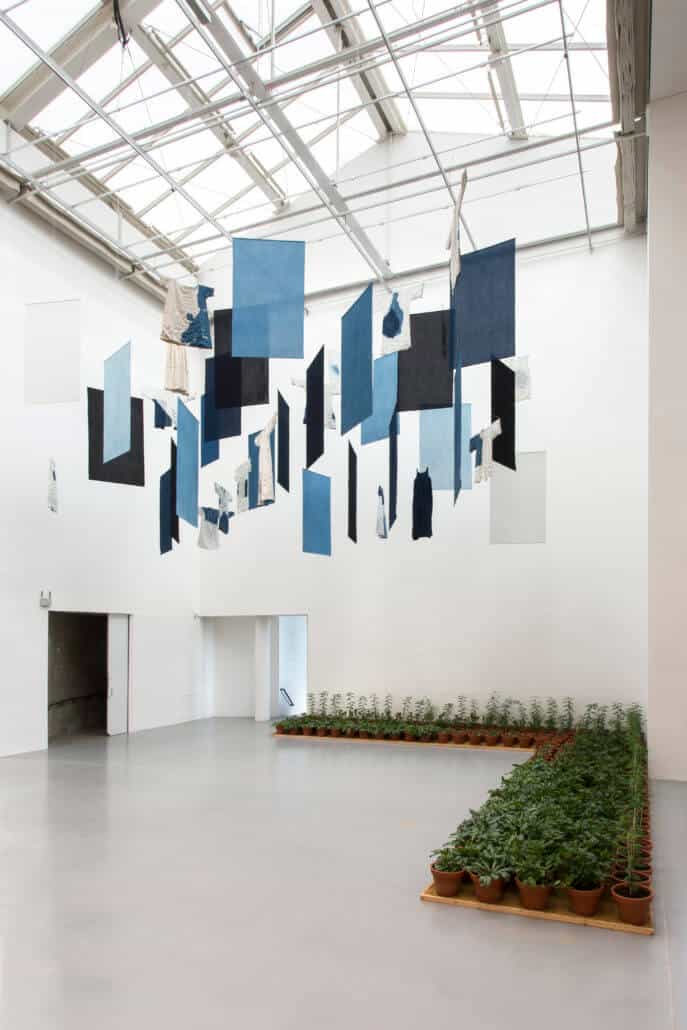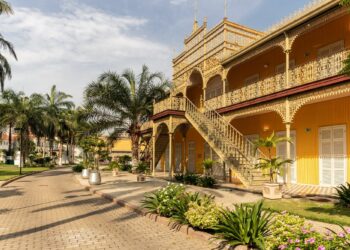documenta 14 in Review
Kassel – Germany, Athens – Greece; documenta 14 is the first of its series to have a dual locus, and together titled Learning from Athens – documenta presents a 163-day urban exhibition. Questioning the socio-politics of learning and what it means to teach, the exhibition discusses education as both liberating and indoctrinating. Social fractures born at once from the residue of migrancy and disquiet of decolonisation have come to inform the discussion around education’s impetus and arts role therein. documenta’s very creation – in purpose of opening Germany’s leftist society, post-Nazi era – points to its criticality, and recognises education as an enduring quality of freedom.

Olu Oguibe (b. 1964, Aba, Nigeria), Das Fremdlinge und Flüchtlinge Monument (Monument for strangers and refugees), 2017. Concrete, 3 × 3 × 16.3m. Königsplatz. Image courtesy of documenta 14.
The immense presence of public art questions ideas around access and migrancy – for example Olu Oguibe’s Das Fremdlinge und Flüchtlinge Monument (Monument for Strangers and Refugees) –placed in relation to a bustling tram stop – which emphasises where, how and when motion translates into migrancy. The public participates simply by passing by or waiting for transport – the work’s very curation highlighting the status of ‘strangeness’ amongst the public, and giving power to Oguibe’s work when pointing to someone as foreign. The involvement of the body in interacting with art is heightened. Viewing the monument is not static but a performance of rootlessness.
This notion of a junction between education and freedom is also made both in documenta’s creation of travelling libraries and open spaces to facilitate a dynamic learning process. Making the public aware of their participation in the inductive process allows for a space of agency, and one is easliy able to consider the role of art in education. Here, the exhibition of the Benin Bronzes – whose history of acquisition remains problematic – has a chance at potential resolution. The public gains a place to give freedom to the art around them. In these spaces, it seems that documenta works to teach as it wishes to learn from itself.

Ibrahim Mahama, Check Point Sekondi Loco. 1901 – 2030. 2016 – 2017, 2016-2017. Various materials, Torwache, Kassel, documenta 14. Photograph: Ibrahim Mahamo. Image courtesy of documenta 14.
Yet documenta also questions teaching as a product of colonial power dynamics. As teaching leans on binaries – those who hold knowledge, and those who don’t – learning conditions the body as it does the mind, where both attitude and behaviour follow education. Hence – documenta points to the spatialisation of knowledge production. The equator indicates a divide in knowing, and thus a divide in power. Aboubakar Fofana’s Fundi (Uprising, 2017), an artwork questioning the ‘firstness’ of colonial knowledge, considers the Malian treasuring of indigo dye – traditionally seen as a symbol of spirituality. The dye was appropriated and soon mass produced in South Carolina due to demand in Europe. The notion of discovery is refuted in highlighting the meaning of each tone of indigo to the Malian people.
As Fofana critiques production under colonial rule, Ibrahim Maham challenges the secrecy around such production with Check Point Sekondi Loco 1901 – 2030. 2016 – 2017. The installation consists of charcoal sacks, purposed to package exports travelling from Ghana to Europe and the Americas. Mahama subverts the politics of architecture of the Torwache building in consuming its form with the sacks of labour. It challenges the urban cartography of Kassel and highlights the exteriority of the building. Shadowed by the exponential rise in immigrants – the exteriority of the space shows how interiority can equate to safety and acceptance. Inside Torwache, images of East European communist monuments and maps of Auschwitz are exhibited, in turn demonstrating how interiority can allude to capture, and simultaneously proving that safety, freedom and liberation are not linear concepts.

Aboubakar Fofana, Fundi (Uprising), 2017. Various materials, installation view, documenta 14 Halle, Kassel, documenta14. Photograph: Roman März, image courtesy of documenta 14.
The synthesis of work from the North and South describe pain as ubiquitous; indoctrination, as universal; and the consequence of politicised education as a capturing of the body and mind. documenta questions the boundaries of freedom – asking if learning can be truly neutral and how it can truly foster freedom. What documenta readily presents both literally and laterally is that education is not reductive – it is a series of questions whose answers may not be found. Education plays with our understanding of what it is to be human, and how art can foster these connections.
– Alexandra Martinez



